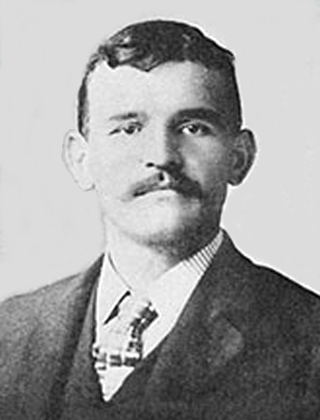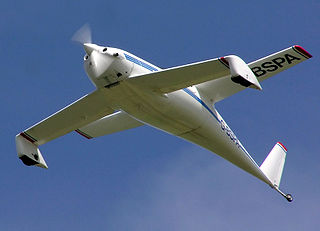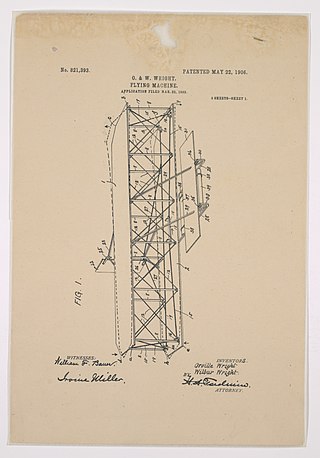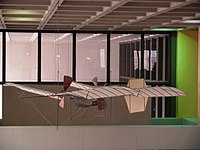
The Wright brothers, Orville Wright and Wilbur Wright, were American aviation pioneers generally credited with inventing, building, and flying the world's first successful motor-operated airplane. They made the first controlled, sustained flight of a powered, heavier-than-air aircraft with the Wright Flyer on December 17, 1903, four miles south of Kitty Hawk, North Carolina, at what is now known as Kill Devil Hills. The brothers were also the first to invent aircraft controls that made fixed-wing powered flight possible.

Samuel Pierpont Langley was an American aviation pioneer, astronomer and physicist who invented the bolometer. He was the third secretary of the Smithsonian Institution and a professor of astronomy at the University of Pittsburgh, where he was the director of the Allegheny Observatory.

The history of aviation extends for more than two thousand years, from the earliest forms of aviation such as kites and attempts at tower jumping to supersonic and hypersonic flight by powered, heavier-than-air jets.
This is a list of aviation-related events from 1903:

Glenn Hammond Curtiss was an American aviation and motorcycling pioneer, and a founder of the U.S. aircraft industry. He began his career as a bicycle racer and builder before moving on to motorcycles. As early as 1904, he began to manufacture engines for airships. In 1908, Curtiss joined the Aerial Experiment Association, a pioneering research group, founded by Alexander Graham Bell at Beinn Bhreagh, Nova Scotia, to build flying machines.

Gustave Albin Whitehead was an aviation pioneer who emigrated from Germany to the United States where he designed and built gliders, flying machines, and engines between 1897 and 1915. Controversy surrounds published accounts and Whitehead's own claims that he flew a powered machine successfully several times in 1901 and 1902, predating the first flights by the Wright Brothers in 1903.

Elbert Leander "Burt" Rutan is a retired American aerospace engineer and entrepreneur noted for his originality in designing light, strong, unusual-looking, and energy-efficient air and space craft. He designed the record-breaking Voyager, which in 1986 was the first plane to fly around the world without stopping or refueling, and the Virgin Atlantic GlobalFlyer, which in 2006 set the world record for the fastest and longest nonstop non-refueled circumnavigation flight in history. In 2004, Rutan's sub-orbital spaceplane design SpaceShipOne became the first privately funded spacecraft to enter the realm of space, winning the Ansari X-Prize that year for achieving the feat twice within a two-week period.
The maiden flight, also known as first flight, of an aircraft is the first occasion on which it leaves the ground under its own power. The same term is also used for the first launch of rockets.

The June Bug was an American "pioneer era" biplane built by the Aerial Experiment Association (A.E.A) in 1908 and flown by Glenn Hammond Curtiss. The aircraft was the first American airplane to fly at least 1km.

The Wright Flyer made the first sustained flight by a manned heavier-than-air powered and controlled aircraft—an airplane—on December 17, 1903. Invented and flown by brothers Orville and Wilbur Wright, it marked the beginning of the pioneer era of aviation.

Early flying machines include all forms of aircraft studied or constructed before the development of the modern aeroplane by 1910. The story of modern flight begins more than a century before the first successful manned aeroplane, and the earliest aircraft thousands of years before.

A tandem wing is a wing configuration in which a flying craft or animal has two or more sets of wings set one behind another. All the wings contribute to lift.
The Manly–Balzer was the first purpose-designed aircraft engine, built in 1901 for the Langley Aerodrome project. The engine was originally ordered from Stephen Balzer (1864–1940) in New York, but his five-cylinder radial engine design failed to live up to its claims. Langley's chief assistant, Charles Manly, then reworked the engine to produce a design that held the record for power-to-weight ratio for any engine for many years. Manly later worked for Glenn Curtiss, and was one of the team-members who designed the mass-produced Curtiss OX-5.

Marine Corps Air Facility Quantico is a United States Marine Corps airfield located within Marine Corps Base Quantico, Virginia. It was commissioned in 1919 and is currently home to HMX-1, the squadron that flies the President of the United States. The airfield is also known as Turner Field, after Colonel Thomas C. Turner, a veteran Marine aviator and the second director of Marine Corps Aviation, who lost his life in Haiti in 1931.

History by Contract is a 1978 book by early aviation researchers Major William J. O'Dwyer, U.S. Air Force Reserve (ret.) and Stella Randolph about aviation pioneer Gustave Whitehead. The book focuses on a 1948 agreement between the Smithsonian Institution and the estate of Orville Wright, which stipulates that the Smithsonian, as a condition of owning and displaying the 1903 Wright Flyer, must recognize and label it as the first heavier-than-air machine to make a manned, powered, controlled and sustained flight.

The Wright brothers patent war centers on the patent that the Wright brothers received for their method of airplane flight control. They were two Americans who are widely credited with inventing and building the world's first flyable airplane and making the first controlled, powered, and sustained heavier-than-air human flight on December 17, 1903.

Charles Matthews Manly (1876–1927) was an American engineer.
Several aviators have been claimed as the first to fly a powered aeroplane. Much controversy has surrounded these claims. It is generally accepted today that the Wright brothers were the first to achieve sustained and controlled powered flight in 1903. Brazil claims its own native citizen Alberto Santos-Dumont as the first successful aviator, discounting the Wrights because their Flyer took off from a rail, and in later flights would sometimes employ a catapult. An editorial in the 2013 edition of Jane's All the World's Aircraft supported the claim of Gustave Whitehead. Claims by, or on behalf of, other pioneers such as Clement Ader have also been put forward from time to time.


















